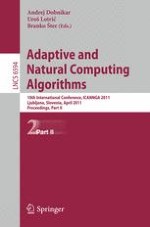2011 | Buch
Adaptive and Natural Computing Algorithms
10th International Conference, ICANNGA 2011, Ljubljana, Slovenia, April 14-16, 2011, Proceedings, Part II
herausgegeben von: Andrej Dobnikar, Uroš Lotrič, Branko Šter
Verlag: Springer Berlin Heidelberg
Buchreihe : Lecture Notes in Computer Science
